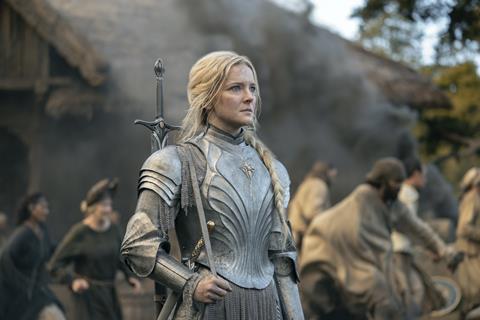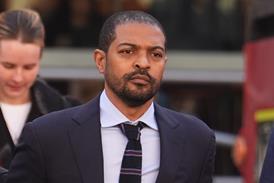Spanish director JA Bayona journeyed to Tolkien’s Middle-earth for The Lord Of The Rings: The Rings Of Power, Amazon’s ambitious prequel series.

When Amazon Studios paid $250m in 2017 for the rights to make a TV prequel to JRR Tolkien’s The Lord Of The Rings, eyebrows were raised by both fans of the books and Peter Jackson’s beloved movie series — as well as rival television executives who greeted the streamer’s sizeable investment with a mixture of scepticism and envy.
After meeting with dozens of filmmakers and potential writers (names bandied about at the time included the Russo brothers and JJ Abrams), Amazon decided to go with relative newcomers JD Payne and Patrick McKay. The pair pitched a five-season story, The Lord Of The Rings: The Rings Of Power, that, while based on Tolkien’s books, took as its starting point six appendices that appeared in The Return Of The King. These passages — which covered events in the Second Age and into the Third Age of Middle-earth — contained family trees and a chart of Elvish scripts, as well as a chronology of the Second and Third Ages. They also included the defeat of the Dark Lord Morgoth, the forging of the Rings of Power, the fall of the island kingdom of Númenor and the rise of the dreaded Sauron.
The Rings Of Power is set many hundreds of years before the story told in The Lord Of The Rings films, focusing on young Elven warrior Galadriel, a character played by Cate Blanchett in Jackson’s films and here by Welsh actress Morfydd Clark (Saint Maud). Galadriel sets out to hunt the once-defeated Sauron, who killed her brother and who she believes is about to return.
Payne and McKay’s intention was to create five seasons of television, almost 50 hours, at a total projected cost of $1bn. But neither man had run a TV show before, much less one of such scope and ambition — and with so much riding on it, financially as well as critically. In fact, their main claim to fame prior to The Rings Of Power was uncredited script work on 2016 feature Star Trek Beyond. To help the pair set up the world of The Rings Of Power, as well as helm the first two episodes, they approached JA Bayona, the Spanish director of The Impossible, A Monster Calls and Jurassic World: Fallen Kingdom, whose previous excursion into episodic television was supernatural show Penny Dreadful.
A massive fan of Tolkien’s novels, having first read them as a child after watching Ralph Bakshi’s 1978 animated adaptation, Bayona was intrigued with what Payne and McKay had in mind. “I didn’t know anything about the show. I didn’t know if it was going to be a remake of the Peter Jackson movies, and I was not interested in that,” he reflects from Barcelona, where he is cutting his latest movie, Netflix’s Society Of The Snow, the true story of the Uruguayan rugby team whose plane crashed in the Andes in 1972. “I sat down with Patrick and JD and they pitched me the whole concept for the show, not only the first season but the five seasons they had planned. I liked the idea of following the appendices because, somehow, we were following a plan set up by Tolkien. At the same time, we had the freedom to create new stories and new characters. So I decided to jump in, which was quite a challenge because we didn’t have much time.”

This was in July 2020, giving Bayona (who also joined as executive producer) just nine months of development before he was set to begin shooting in New Zealand. “In that time, we had to develop all the visuals of the show. The designs of every single kingdom. And we had four different kingdoms in the first two episodes,” he says. “It was quite a challenge because we didn’t have the time Peter Jackson had for his movies. Everything was very quick. In August we were already doing castings and watching a lot of taped auditions, and we started visual development in Barcelona in September and October. From there, I jumped to LA and then immediately to New Zealand.”
Joining Bayona were cinematographer Oscar Faura, who had shot the director’s previous four features dating back to 2007’s The Orphanage; production designer Ramsey Avery, whose credits include 10 Cloverfield Lane and Hotel Artemis; and costume designer Kate Hawley, known for Crimson Peak and Edge Of Tomorrow (Hawley shares credit with Rick Heinrichs, longtime Tim Burton collaborator, who was attached before Bayona came on board).
While The Rings Of Power could utilise design elements from Jackson’s films — and, like them, would be shot in New Zealand — Bayona was determined to break new ground, design-wise, helped by the fact his story takes place in the Second Age (both The Lord Of The Rings and The Hobbit take place during the Third Age). “The Second Age is a very interesting period because it’s right at the end of the war against Morgoth, and we are starting a time of splendour but something is boiling under the surface,” he notes. “From those ideas, I started to develop a visual storytelling of what the show was going to be. To me, there was something very symbolic about most of the scenes we had in those first two episodes, and from there I evolved a lot of the visual concepts of the show.”
Visual inspiration came from a variety of sources, some cinematic, some photographic, some real world. “The whole concept for [the Elven capital of] Lindon was a forest as a cathedral,” he explains. “That came from Gaudi. I’m from Barcelona, so I’m very familiar with La Sagrada Familia [the famed architect’s church in the city].” The dwarves’ subterranean world of Khazad-dûm, meanwhile, had its roots in German and Russian expressionism, from the silent work of Sergei Eisenstein to that of Andrei Tarkovsky. “Especially in the second episode, you can see references to Tarkovsky movies.” Pre-Raphaelite painters influenced the look of the elves, while the Harfoots and their nomadic lifestyle took inspiration from traveller communities. “They had to feel like they had to be able to move constantly, so couldn’t have lots of possessions. And they had to feel rawer than the hobbits we know.”
Visual storytelling
Tolkien’s books were, of course, another great font of knowledge and inspiration for Bayona and his creative team. “There’s something about how Tolkien uses landscape and nature to tell the psychology of the characters that’s very cinematic,” he explains. “To me, he was a visual storyteller. The way he uses light and darkness, colour and textures. So it was a question of finding those images, which was challenging because when you talk about television, you don’t talk much about visuals. It’s always about the script, about performances. But I was there to bring images to the show, to tell the story in a very cinematic way, the same way you have those big images in your mind when you read Tolkien. Very early on I decided to shoot in the widest aspect ratio.”
Bayona was halfway through shooting his two episodes when Covid shut down the production. But the enforced layoff worked to his advantage. “Before Covid we were close to shooting Monday to Thursday then preparing on Fridays. That’s when Covid happened. At the same time, it gave us six months to keep editing and keep developing the show. It gave us extra time that was very helpful for us. We planned to be there nine months and we stayed a year and a half to shoot those two episodes and develop the whole world for the first season.”
Part of that included using non-white actors, a decision that brought with it some ugly online criticism. “It was very shocking to see some of the reactions,” recalls Bayona. “I had lots of messages complaining about the diversity. I was reading all those reactions from people who were complaining because there were African American people in the show or Asian people, and I thought, ‘Did they only get the superficial part, the look, but not what the story was about?’ It’s a story about how we are all part of the same team, that all different people — dwarves, elves, humans — need to come together to fight evil. To me, those people didn’t get the message of Tolkien.”

























No comments yet